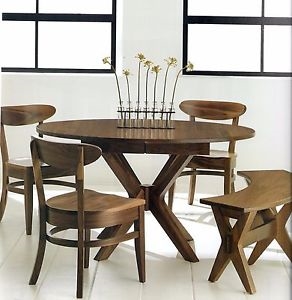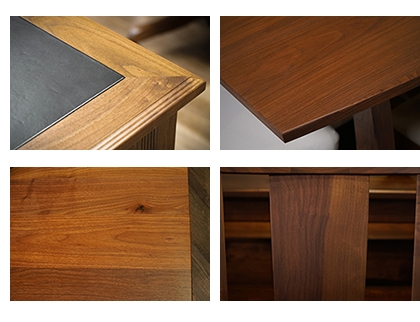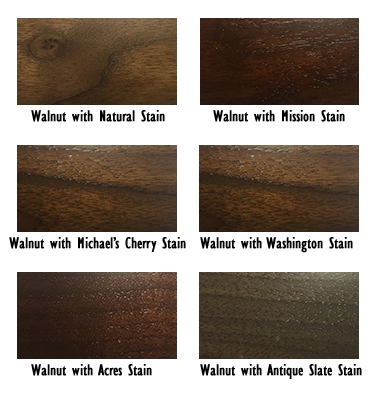Walnut Furniture
Walnut wood is loved for its strength and durability, and for its rich brown colors. The versatility of walnut wood makes it a leading choice for formal executive office furniture as well as the clean lines of mid-century modern designs.

Dark and exotic with a formal flair,
With lots of brown shades shining everywhere,
For furniture and cabinets the strong boards are cut,
Experience the smooth richness of hearty walnut.
The Look of Walnut Furniture
Walnut is considered a dark wood and displays a range of colors from light to dark brown.
Walnut’s sapwood (the wood from the outer part of the tree) is pale yellow to white in color, while the rich heartwood (from the center of the tree) holds shades of brown from light pale brown to dark chocolate brown with some dark brown streaks. Walnut wood can include purple or gray tones and sometimes figured patterns like burls and curls are present.
Walnut Wood Grain
Walnut wood grain is fine and generally straight with a medium texture. It can contain some irregularities like knots and extra sap. Waves, curls or burls that are present in the wood grain are a result of knots in the wood. Their presence creates such unique patterns that they add to walnut furniture’s unique look and walnut wood with intricate grain patterns is held in high regard.

Is Walnut Furniture as Strong as the Others?
Walnut furniture offers up a hefty dose of strength you can rely on. On the Janka Hardness Scale that rates the hardness of wood, walnut wood comes in at 1010. To give you an idea of where walnut falls among other hardwoods, cherry wood has a Janka hardness rating of 950, and red oak has a rating of 1290, placing walnut wood among the elite contenders for quality solid wood furniture. Walnut wood is dense, absorbs shock well and resists decay.
Can I Stain or Paint Walnut Furniture?
Walnut wood polishes to a smooth finish and woodworkers love working with it because it glues well, accepts stains well and is easy to carve and turn for unique features. Walnut responds well to steam bending techniques as well. Walnut’s dark color is not ideal for paint. Walnut wood looks stunning in both dark stains that enhance its deep tones as well as a clear coat finish or oiled finish that brings out its rich hues. It’s important to note that walnut furniture with an oiled finish should be oiled from time to time, rubbing oil into the wood perhaps once a year.

What Makes Walnut Wood Special?
Woodworkers love to work with walnut wood and its darker hues make it stand out from the rest.
Here’s what you’re getting with walnut wood:
- Rich, dark-colored wood showcasing a variety of browns.
- Versatile wood that can be used with its natural colors highlighted in a natural oil finish or can be further enhanced with dark stains.
- Popular for its color, strength and durability.
- Easy to carve for intricate designs and ornate walnut furniture.
- Won’t warp, absorbs shock well and naturally resists decay.
- Color will actually lighten over time. (This change in color is not as dramatic as the darkening of colors in cherry wood.) This lightening can be slowed with an oil finish.
Most Common (and not so common) Uses for Walnut Wood
- Furniture
- Cabinets
- Flooring
- Instruments like violins and guitars
- Gunstocks for its shock resistance and stability
- In chess and checkerboards—it looks stunning when used with a lighter colored wood
Why Walnut is Used in Furniture
- For its rich, dark brown hues.
- It’s easy to carve, making it great for shaping, turning and adding intricate details.
- Works easily with hand tools, nails, and screws.
- Glues well creating strong frames and foundations.
- Responsive to steam bending.
- Naturally resistant to decay and can last a lifetime or longer.
- Creates a beautiful contrast when used with lighter colored woods.
Where Walnut Comes From
There are several species in the walnut family. Walnut trees that grow in America are found in the central and northeastern United States. Most popular for walnut furniture is Black Walnut (also called American Black Walnut or American Walnut) and English walnut.
Walnut is a deciduous hardwood (it loses its leaves each year). Walnut trees can grow between 100 to 120 feet tall with trunks 30” to 40” in diameter.
Why Walnut Furniture Costs More
While abundant, walnut trees are not as abundant as cherry or maple trees. They also don’t grow quite as tall, so there is less walnut produced per tree than other premium hardwood trees. Walnut wood is usually not available in long boards and has more knots to work around. Walnut is also considered a premium wood, adding to its price tag.
Walnut Wood and Live Edge Furniture
Some large cross sections of walnut lumber are used for live edge slabs. Live edge furniture exhibits the natural edge of the wood. Walnut’s strength and shock resistance make it a great candidate for live edges, creating beautiful live edge countertops, tables, benches and more.
How do I Keep my Walnut Wood Looking New?
View tips on how to care for your walnut furniture on our Caring For Wood Furniture Page.
You reach our team of furniture specialists by email or toll free at 1-866-272-6773 with any questions.

